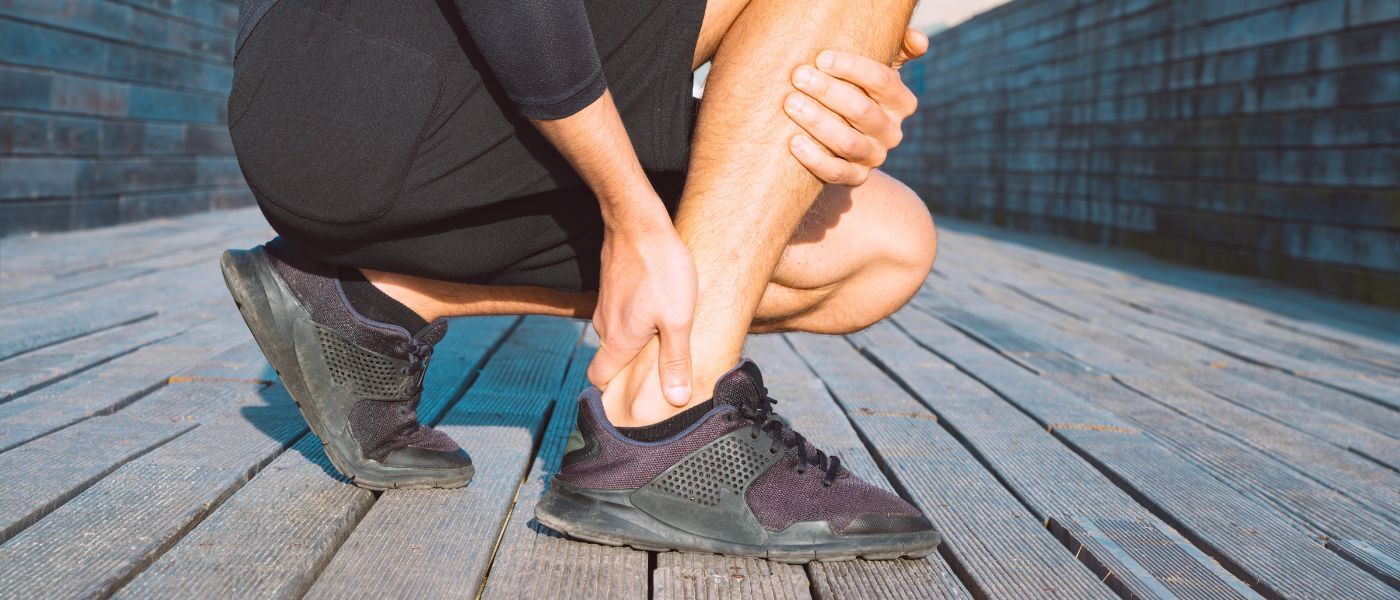How I Healed from My Achilles Surgery in Record Time (Without Spending $1 Million Like Aaron Rodgers)
October 1, 2024, marks one year since I fully ruptured my right Achilles tendon. I was at a customer’s house, admiring his classic vintage cars (I’m a car enthusiast, by the way), when one of his cars wouldn’t start. As I helped him push it out of the garage to jump the vehicle, the car rolled back unexpectedly. All I heard was a loud pop — my right foot and calf felt completely disconnected.
The shock came quickly, especially since my customer, a local pain physician, called in his orthopedic surgeon colleague immediately. After an MRI the next day, it was clear my Achilles tendon was retracting, and I needed surgery right away.
On October 10th, I went in for surgery. Waking up from general anesthesia wasn’t fun, but thanks to a local nerve block, I didn’t feel any pain for the first 72 hours. Once that wore off, the nerve pain kicked in. Determined to avoid opioids, I turned to homeopathic remedies — Hypericum, Arnica Montana, and Rhus Tox — which helped manage the pain.
Post-surgical care is critical for proper Achilles healing, and I knew that a quick recovery meant focusing not only on the basics but also on biohacking my way to success. I’ve seen simple Achilles surgeries go wrong, so I developed a personalized plan. Here’s what I did:
Protein Intake: The Building Block for Tendon Repair
Protein is essential for muscle and tendon repair, especially post-surgery. I made sure to increase my intake of high-quality protein sources, focusing on collagen, which is rich in amino acids like glycine and proline — vital for tendon healing. I also added protein supplements such as bone broth and grass-fed beef protein — targeting at least 1.5 to 2 grams of protein per kilogram of body weight to optimize recovery.
Red Light Therapy: Supercharging Cellular Healing
I used the Therasage TriLite Red Light Panel to stimulate collagen production and reduce inflammation. Red light therapy penetrates the skin to activate mitochondria, which helps accelerate tissue repair at the cellular level. This technology has been crucial in my recovery, helping to decrease swelling and speed up tendon regeneration.
PEMF Technology: Promoting Cellular Regeneration
Pulsed Electromagnetic Field (PEMF) therapy was another tool I used to accelerate recovery. PEMF enhances circulation, reduces pain, and promotes faster tissue healing by recharging the cells with energy. I used a PEMF mat daily for about 30 minutes to stimulate the regeneration of my Achilles and improve overall healing.
Methylene Blue: A Mitochondrial Boost
Methylene blue is a potent antioxidant that supports mitochondrial function. I used it to reduce oxidative stress and inflammation, helping me heal faster. By improving cellular energy production, it played a significant role in reducing the downtime after surgery. Be sure to consult with a healthcare provider before using this.
Phospholipid, Fatty Acid, & TUDCA: Supporting Cellular Integrity and Preventing Scar Formation
Phospholipids and essential fatty acids, combined with Vitamin C, were integral to restoring cell membrane integrity and stimulating stem cell regeneration. I used BodyBio’s PC (Phosphatidylcholine) and Balance Oil, which is rich in Omega-6 and Omega-3 fatty acids, and added TUDCA (Tauroursodeoxycholic acid) to my protocol.
Why Phospholipids and Omega-6 + Omega-3 Fatty Acids are Crucial for Tendon Healing
Phospholipids are the building blocks of cell membranes, playing a vital role in cellular repair and regeneration, especially after surgery. Phosphatidylcholine (PC), a key phospholipid in BodyBio’s PC, helps maintain the structure and fluidity of cell membranes, allowing for optimal cell function and communication. After surgery, the body's demand for phospholipids increases due to the rapid turnover of damaged cells and tissues. PC supports the restoration of damaged soft tissue, including tendons, by promoting efficient cellular repair and regeneration.
Essential fatty acids, particularly Omega-6 (Linoleic Acid) and Omega-3 (DHA/EPA), are critical for managing inflammation and supporting the healing of soft tissues. Here’s how they work:
- Reducing Inflammation: After surgery, the body undergoes an inflammatory response as it begins to repair damaged tissues. Omega-6 fatty acids, particularly gamma-linolenic acid (GLA), are precursors to anti-inflammatory molecules called prostaglandins that help regulate the inflammatory process. However, it’s the Omega-3 fatty acids (EPA and DHA) that are most crucial in healing, as they produce resolvins and protectins — specialized pro-resolving mediators (SPMs) — that actively reduce inflammation and facilitate tissue repair.
- Supporting Collagen Synthesis: Omega-3 fatty acids (EPA and DHA) also enhance the production of collagen, a major structural protein in tendons. Collagen provides strength and flexibility to the tendon tissue, ensuring it can withstand the stress of movement as it heals. Omega-3s promote a healthy inflammatory response that supports the repair of collagen fibers, ensuring the tendon heals with greater integrity and reduced scarring.
- Cell Membrane Integrity and Tissue Regeneration: Phospholipids and fatty acids help maintain the integrity of cell membranes, which is crucial for effective tissue repair. Damaged tendons need to regenerate their cellular architecture, and healthy cell membranes ensure that nutrients, oxygen, and biochemical signals are efficiently transported to the injured site. By supplying phospholipids and Omega-3 and Omega-6 fatty acids, we promote better membrane fluidity, which optimizes cell communication and tissue repair.
- Modulating Fibrosis and Scar Formation: Omega-3 fatty acids are known to limit fibrotic responses by regulating the body's response to TGF-β (Transforming Growth Factor-Beta), a key player in scar tissue formation. This reduces the risk of fibrosis (excessive scarring), which is especially important for soft tissue injuries like Achilles tendon ruptures.
TUDCA: Preventing Keloid Formation and Enhancing Tissue Repair
In addition to phospholipids and fatty acids, I incorporated TUDCA into my protocol. TUDCA not only supports liver health but has demonstrated potential in preventing keloid formation after surgery. Here’s how:
- Mechanism of Action: Studies in rabbit models have shown that TUDCA significantly reduces scar formation compared to saline or steroid injections. It works by inhibiting the activation of IRE, ERK, and ATF4, key components of the unfolded protein response (UPR) in cells. This, in turn, reduces the transcription of TGF-β, a protein involved in the development of fibrosis and excessive scarring. By modulating these pathways, TUDCA minimizes scar tissue formation, allowing for a smoother recovery with reduced risk of keloid scars.
- Promoting Angiogenesis and Tissue Regeneration: TUDCA has also been shown to promote angiogenesis (the formation of new blood vessels) and osteogenic differentiation in endothelial cells and mesenchymal stem cells, which are essential for healing. By promoting better blood flow to the injured site and supporting the formation of healthy new tissue, TUDCA accelerates the overall healing process.
- Additional Benefits of TUDCA: TUDCA has broader effects that support recovery, including its ability to activate the Nrf2 signaling pathway, which enhances the body’s antioxidant defenses, protecting tissues from oxidative stress during the repair process. This multi-faceted approach ensures that tissues regenerate healthily and are less prone to scarring or dysfunction post-surgery.
I also took StemRegen to release stem cells and support my body's natural repair process. This combination of nutrients helped regenerate healthy tissue, ensuring my Achilles became stronger than before.
Injectable Peptides: Advanced Healing Support
To boost my healing even further, I used injectable peptides such as BPC-157, Thymosin Beta-4 (TB500), KPV, and GHK-Cu. These peptides are known for their ability to enhance tissue repair, reduce inflammation, and promote faster recovery:
- TB500: Reconstituted and injected subcutaneously to reduce inflammation and accelerate tendon healing.
- BPC-157: Promoted tendon and ligament repair, used twice daily for two weeks and then cycled monthly.
- KPV: Used for its anti-inflammatory properties, decreases histamine response, and increases collagen formation.
- GHK-Cu: This powerful copper peptide is known for its role in tissue regeneration and wound healing. I used a GHK-Cu nasal spray, which helped stimulate tissue repair and reduced inflammation. GHK-Cu also supports collagen production and reduces oxidative stress, making it an essential part of my peptide regimen.
Peptides have been game-changers in my healing process, allowing for faster tissue repair than I could have achieved naturally.
Heart Coherency Breathing: A Mind-Body Approach to Healing
Recovery isn’t just physical — it’s mental too. I practiced heart coherency breathing, a simple technique where you focus on slow, deep breathing to regulate your nervous system. This helps shift the body into a parasympathetic state, which is crucial for healing. Reducing stress was key in speeding up my recovery and optimizing my body’s natural repair mechanisms. Visit heartmath.com for more information on heart coherency breathing.
Physical Therapy: The Essential Step
While all the biohacking tools were powerful, physical therapy was the cornerstone of my recovery. The moment my surgeon cleared me to start, I got to work with a skilled therapist. Achilles injuries can leave you vulnerable to re-injury, and physical therapy helps rebuild strength, mobility, and flexibility in the tendon. It’s essential to not skip or delay this stage, as proper rehabilitation prevents future complications.
Eight months of rehab later, I’m thrilled to share that I am now able to jump and fully sprint again! Daily exercises and focusing on functional movement have been key to strengthening not only my Achilles but also my overall body. Building resiliency in the body is essential — not just for recovery but for overall health and injury prevention.
By combining cutting-edge biohacks with a solid physical therapy plan, I was able to heal quickly and build a stronger Achilles tendon. My recovery wasn’t a straight path, but each element of my routine — along with expert guidance from my care team — made a huge difference.
If you're recovering from a similar injury, be sure to talk to your physician before implementing any of these strategies. The right combination of nutrition, technology, and rehabilitation can make all the difference in your healing journey.
Hear more from Dr. Kim at https://www.drkimwellness.com/





